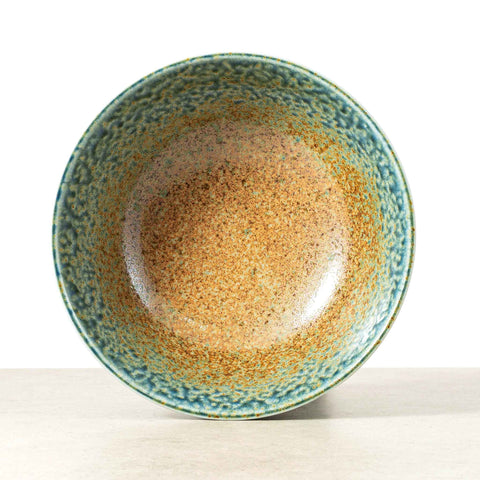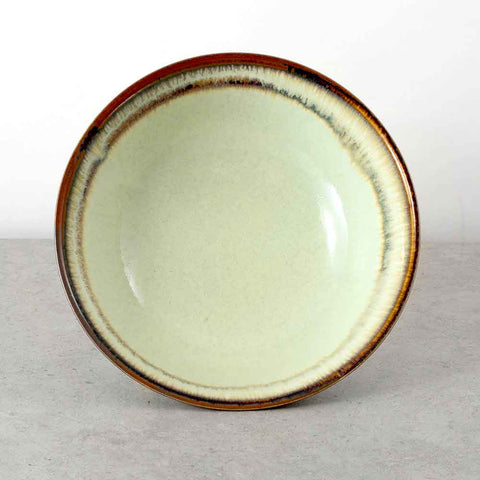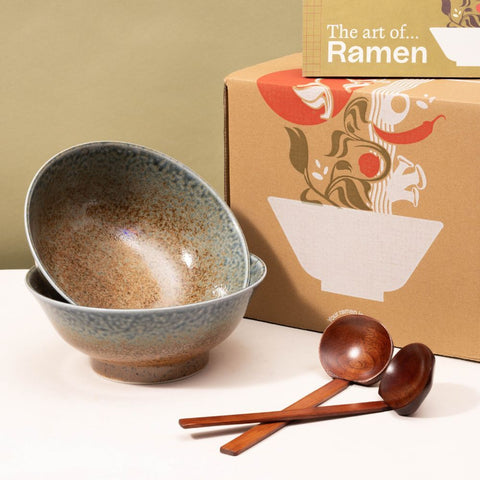Everything You Need To Know About Ramen Bowls
by The Sous Chef Team

Ramen bowls are more than just a way to serve noodles. Ramen bowls, or ramen bachi, are part of the joy of eating ramen itself.
The wide suface gives space for the toppings, the depth keeps the broth piping hot, and the design often tells a story of Japanese craft.
So what should you look for in a good ramen bowl? In this guide, we’ll explore everything you need to know about ramen bowls – from sizes and shapes to choosing the perfect bowl for your kitchen.
Or if you want to discover Japanese food & ingredients, check out our Japanese food, cookware & ingredients, or learn more about Japanese recipes!
The photograph above is a stack of yukishino ramen bowls at the Professional Ramen School in Osaka. Just before service.
Anatomy Of Ramen - And Why It Matters!
There are 5 essential components to a classic ramen:
- Broth: The heart and soul of any ramen, bringing rich flavour to the bowl. It must be served piping hot! So any bowl needs to be deep so the broth doesn't cool.
- Noodles: The foundation, providing the satisfying texture that makes ramen memorable.
- Toppings: A play of textures and flavours, from pork chashu to vegetables to ramen eggs, adding depth and texture to each mouthful.
- Seasonings: Simple yet impactful, these enhance the overall taste of your ramen. Try miso!
- Garnish: A finishing touch! That can turning your bowl into a work of art... You can try adding spring onions, or shichimi togarishi spice.
A ramen bowl needs to hold these together, and look stunning presented to the diner:
- Depth: Your ramen bowl must be deep enough to hold enough broth to keep your noodles hot and submerged.
- Width: It needs to be wide enough to contain toppings such as sliced meat or a halved nitamago ramen egg. And the bowl should allow you to combine a perfect mouthful of all the elements in one swoop of your chopsticks.
The Best Size for Ramen Bowls
Ramen bowls need to be big enough to fit both broth and toppings without feeling overcrowded. A 20–22cm bowl is the ideal size for a single serving of ramen. Smaller bowls may be fine for side dishes or rice, but ramen bowls are intentionally large – so you can enjoy every layer of flavour, from broth to garnish.
Authentic Japanese Ramen Bowls

So what makes ramen bowls different from other bowls?
Ramen bowls are deep and broad. Cradling your noodles and toppings perfectly. They're not too big, not too small – just the right size for a satisfying slurp. No frills, just function.
You may not fill them to the brim with ingredients. But the size allows you to combine different elements in each mouthful. And to move your noodles about freely, to coat in seasoned broth - without risk of spilling!
Now, let's tackle the comparisons. A ramen bowl stands out with its depth, while a pho bowl is more shallow, and an udon bowl tends to be wider. Simple distinctions that make a big difference in your noodle experience.
How to Choose the Right Ramen Bowl for Your Kitchen
When selecting a ramen bowl, think about:
- Size: Go for at least 20cm wide to hold noodles, broth and toppings, with a sturdy foot.
- Material: Ceramic ramen bowls retain heat well and feel satisfying to hold.
- Design: From minimalist white to bold, hand-painted Japanese patterns, choose a look that suits your table. And if you’d like an authentic design, take a look at our Japanese Blue Wave ramen bowls, or Sakura Blossom ramen bowls.
-
Functionality: Many ramen bowls are dishwasher- and microwave-safe, making them practical for everyday use.
Where to Buy Authentic Ramen Bowls
At Sous Chef, our ramen bowls collection includes traditional Japanese ceramics alongside contemporary designs. Below are the selection of ramen bowls chosen by the Sous Chef team.
They are all bowls you'd find in a ramen shops or bars in Tokyo! All are dishwasher safe.
Attractive duck-egg blue edged stoneware bowl decorated with a traditional glaze.
The speckled bowl is decorated with a deep blue glaze on the outside, which fades to a sandy-coloured glaze on the inside. Japanese tableware is designed to be mixed and matched at the table with other designs, colours and textures.
'Komorebi' is a Japanese word meaning ‘sunlight filtering through trees’, a vision conjured up by the delicate interplay between the different shades of green and golden sandy colours on this glazed stoneware ramen bowl.
Use the mizumi ramen bowl for hearty servings of authentic Japanese ramen. The large bowl is also just right for a warming portion of Japanese curry with rice.
The ramen bowl is finished with a multi-tonal deep blue glaze, making it look like a serene lake.
If you’re looking for ramen bowl sets, we have it too! These classic ramen bowls come with a booklet of tried and tested ramen recipes. Along with two bamboo ramen ladles. They are packed in beautiful Sous Chef canvas bags - the ideal gift for any food lover.
The Japanese ramen bowl set is your shortcut to ramen mastery! The start to perfect ramen is a gorgeous ramen bowl to serve it in, and this set will certainly give you that. Each ramen bowl is imported from Japan, and carefully chosen with the perfect size and shape for ramen. They are dishwasher safe.
The gorgeous set contains two ramen bowls, two ramen ladles, and a full colour ramen recipe booklet.
The Karasuba-iro ramen bowl set is a gorgeous gift for anyone who loves Japanese food.
The gorgeous set contains two deep black hand-glazed ramen bowls, two ramen ladles, and a full colour ramen recipe booklet.
The chouseki ramen bowl set will have you making the best ramen in no time at all! The gorgeous set contains two chouseki ramen bowls, two ramen ladles, and a full colour ramen recipe booklet.
The chouseki noodle bowl is decorated with a deep blue glaze on the outside, which fades to a sandy-coloured glaze on the inside. Each ramen bowl is imported from Japan, and carefully chosen with the perfect size and shape for ramen.
Ramen Bowl Recipes

Feeling inspired? Check out a few of the ramen recipes we love here at Sous Chef. And browse all the Japanese ramen ingredients you need to start cooking!
Miso Ramen
Miso ramen is perhaps a misnomer. Yes, the Japanese soup contains miso - around 1 tbsp per portion - but the layers of flavour bring so much more. The recipe starts with a basic chicken stock, yet the real thrill of the dish lies in the additional toppings.
To make life easier it may be worth preparing some - or all - of the components the day before. Even the soft boiled eggs will keep well overnight. You may well be tempted to leave out something here and there, but don't. It's a recipe worth making in the whole.
Tonkotsu Ramen
‘Tonkotsu’ literally translates as pork bones. Which is an accurate description of this Japanese food, which transforms an apparently useless pile of bones into heart-warming, lip-smackingly delicious ramen broth.
A seemingly simple bowl of tonkotsu ramen made by a ramen expert might include six to eight sub-recipes. Ramen masters can spend significant time calculating exact salinity of the tonkotsu broth before adding more clever salt solutions, perhaps made from dried fish, and even sweetening the broth.
However we've simplified all that to create a quick and easy tonkotsu ramen recipe that's a fantastic alternative to eating in one of Tokyo's best ramen joints. The very long cooking time and the rolling boil result in a beautifully creamy tonkotsu broth.
Tahini Tantanmen Ramen
This recipe is inspired by tantanmen ramen – a Japanese take on Sichuan dan dan noodles, with a broth made from soya milk and sesame – but it is by no means authentic.
Typically, this would have a proper stock as the base and be topped with minced (ground) pork, but I got attached to the idea of a ramen that could be knocked up quickly and that remained vegetarian/vegan.
Udon noodles is used in this recipe because of how much Alexina Anatole loves their texture: big, fat, slippery, chewy!
This is a perfect lunch or dinner for two, in part because the mushrooms and leeks benefit from not being overcrowded when you cook them.
Ramen Bowl Etiquette
Ramen bowls come with their own set of table manners. It’s not simply a case of serving and eating. Before you dish up in your new favourite ramen bowls, take a look at these etiquette ‘rules’...
- Slurping: Don't be shy – slurping your noodles is a sign you're enjoying your meal!
- Bowl manners: Keep the bowl on the table; lifting it to your mouth is a no-no.
- Silent enjoyment: Ramen time is quiet time; avoid overly loud conversations and simply enjoy the dish.
If you’re curious about more ramen history and expertise, check out our guide to How To Eat Ramen The Right Way!
Final Thought
Ramen bowls are more than just practical tableware – they’re part of the joy of cooking and eating ramen. Choosing the right bowl makes every serving feel authentic, from the way the broth steams to how the toppings are displayed.
Explore our full ramen bowls collection and find the perfect bowl for your kitchen.

About the author
The Sous Chef team spends all day, every day hunting out the most exciting flavours, trends and recipes from across the world.
Every single team member tastes ingredients weekly, and cooks with the most up-to-date and classic cooking tools regularly. We're experts in ingredients and cookware from around the world.
We are constantly tasting new products, trying new recipes, and speaking to expert producers. For recipes and inspiration from the Sous Chef team, sign up for emails here.








